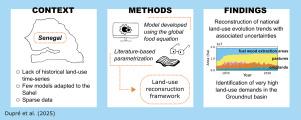Revisiting the dynamic simulation model of land-use changes in the Sudano-sahelian countries of Africa (SALU): An open-access application to Senegal
IF 3.2
3区 环境科学与生态学
Q2 ECOLOGY
引用次数: 0
Abstract
In the Sahel, the sustainability of human land-use is threatened by climate change and demographic pressure. Research is urgently needed to provide governments with relevant leads to prevent land degradation and ensure the population access to resources such as food and fuelwood. Little observation data is available, and canonical land-use models have difficulty representing Sahelian dynamics. One of the few models developed to fit characteristics of the region is the dynamic simulation model of land-use changes in the Sudano-Sahelian countries of Africa (SALU) developed by Stephenne and Lambin (2001). This study aims at adapting this model to the current state of the art, providing explicit calculation steps, to reconstruct past land-use dynamics in Senegal from 1961 to 2020. An extensive bibliographic search was used to obtain parameter value ranges and the model’s sensitivity to parameter uncertainties was assessed through -indices calculation. Applying the model at national scale predicted trends coherent with available literature, with agricultural expansion leading to deforestation, and a switch to intensification in the mid-1990s affecting both livestock forage consumption and fallowing time. Calculating land-demands in the Groundnut basin, a subregion of Senegal, showed the limits of the model when downscaling, with current hypotheses insufficient to reconstruct land-uses in the region when faced with demands too high to be satisfied by the local production. This work opens perspectives to refine land-use modeling in the Sahel, including prospective scenarios.

重新审视非洲苏丹-萨赫勒地区国家土地利用变化动态模拟模型:塞内加尔开放获取应用
在萨赫勒地区,人类土地利用的可持续性受到气候变化和人口压力的威胁。迫切需要进行研究,为各国政府提供相关线索,以防止土地退化,并确保人口获得粮食和薪材等资源。观测数据很少,规范的土地利用模型难以代表萨赫勒地区的动态。为数不多的适合该地区特征的模型之一是Stephenne和Lambin(2001)开发的非洲苏丹-萨赫勒国家(SALU)土地利用变化动态模拟模型。本研究旨在使该模型适应当前的技术状况,提供明确的计算步骤,以重建1961年至2020年塞内加尔过去的土地利用动态。通过广泛的文献检索获得参数取值范围,并通过δ指数计算评估模型对参数不确定性的敏感性。在全国范围内应用该模型预测的趋势与现有文献一致,农业扩张导致森林砍伐,以及20世纪90年代中期向集约化的转变影响了牲畜饲料消费和休耕时间。计算塞内加尔的一个分区域Groundnut盆地的土地需求,显示出模型在缩小规模时的局限性,当面临当地生产无法满足的高需求时,目前的假设不足以重建该区域的土地使用。这项工作为改进萨赫勒地区土地利用建模(包括预期情景)开辟了新的视角。
本文章由计算机程序翻译,如有差异,请以英文原文为准。
求助全文
约1分钟内获得全文
求助全文
来源期刊

Ecological Modelling
环境科学-生态学
CiteScore
5.60
自引率
6.50%
发文量
259
审稿时长
69 days
期刊介绍:
The journal is concerned with the use of mathematical models and systems analysis for the description of ecological processes and for the sustainable management of resources. Human activity and well-being are dependent on and integrated with the functioning of ecosystems and the services they provide. We aim to understand these basic ecosystem functions using mathematical and conceptual modelling, systems analysis, thermodynamics, computer simulations, and ecological theory. This leads to a preference for process-based models embedded in theory with explicit causative agents as opposed to strictly statistical or correlative descriptions. These modelling methods can be applied to a wide spectrum of issues ranging from basic ecology to human ecology to socio-ecological systems. The journal welcomes research articles, short communications, review articles, letters to the editor, book reviews, and other communications. The journal also supports the activities of the [International Society of Ecological Modelling (ISEM)](http://www.isemna.org/).
 求助内容:
求助内容: 应助结果提醒方式:
应助结果提醒方式:


